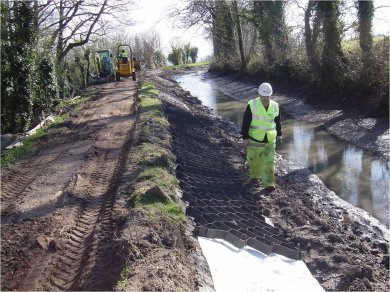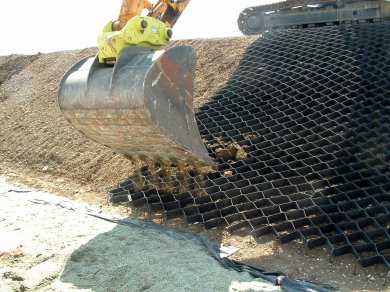Publish Time: 2022-12-27 Origin: Site
Composed of virgin HDPE plastic, geocell grids are a system of welded cells creating a stable structure of cell walls to provide cellular confinement support to slope, base, channel, and vertical applications. By distributing the load across an extended area, the stress on the geocell grid and the sub-grade below is greatly reduced. This allows one to reduce the thickness of the structure in base applications or increase the strength and integrity of the reinforced structure. One can also utilize lower quality fill material when using geocells as the number of cell walls allows for excellent distributed load support as well as provides soil particle retention in slope and channel applications.. For information on additional Zhongloo products for your specific application feel free to contact us (https://www.zlgeo.com/contactus.html).

When fastened together and placed on subsoil surfaces, interconnected geocells that expand and prop open can accommodate different types of infill materials such as soil, aggregate, recycled materials and more. These materials are then compacted to provide additional strength. Geocells provide increased performance for many different construction applications, either allowing slimmer structures or additional reinforcement.

Cellular Confinement System for Earth and Water Flood and Water Control:
The battle to prevent flooding runs into the millions of dollars in construction or temporary dam raising. If flood waters are not properly contained, it can lead to loss of life, millions of dollars from property damage, and the incalculable toll on everyone's livelihoods.
Although the most common practice for controlling floods are the use of sandbags. The cell structure has many advantages over sandbags. Filling sandbags take a great deal of time and energy. Workers become easily tired and terrible choices must be made to decide which areas will be protected and which won't.
Less labor is required than filling and stacking sandbags because earth-moving machines can fill the cells with sand very quickly. Also, the cells are constructed as a vertical wall, where sandbags must be stacked similar to the shape of a pyramid, and great deal more sand will be needed.
Easy to construct, these cells are lightweight, are very rugged and exceptionally strong to withstand different levels of water volumes. The units can be carried by hand and brought in on equipment or dropped from helicopters without causing any damage. You can store the units out of the sun for years without deteriorating and will resist mildew and pests. These units are very effective as flood control barriers and for levee construction; both rising and repairing.
Gun Firing Range Protection Walls Applications:
These walls are an all-textile cellular containment system used for constructing structures from earth, sand, and other materials. When filled with sand or earth, the cell wall has no metal or plastic components, making it perfect for use at gun clubs. Fire range walls have ricochet hazards that need to be addressed for the reduction or elimination of these dangers.
Zhongloo (https://www.zlgeo.com/contactus.html) Geo Cell is the ultimate solution for the construction of small arms and close-quartered battle ranges. It will allow for a realistic, close quartered battle training with high-velocity weapons. It provides internal wall protection for multiple teams within the complex. It's also a very effective solution to add needed height on existing range wall berms, the addition of range dividing walls, obstacles and target protection.
These units are extremely flexible, cost effective modular alternative to standard range building techniques, providing maximum flexibility with minimal maintenance
Applications Include:
• Firing Range Walls
• Gun Clubs
• Ballistics Protection
• Blast Protection
• Vehicle Barriers
• Force Protection

Construction Erosion & Sediment Control:
Water can erode top soils, wash away priceless plantings, pollute downstream and create enormous gullies. Even though these are regulated issues, current erosion control products can become overwhelmed by the soil and water that they are supposed to prevent.
The heavy-duty geotextile fabric of these units adapt to the terrain while providing excellent structural durability and strength. As a matter of fact, the easy to construct cellular confinement system is perfectly suited for irregular terrain including slopes, in order to reduce erosion while promoting vegetation. These systems are also cost efficient as you can use mulch or fill from the site. Water filters through the system while fill materials and soil particles are kept back by the geotextile.
Once the erosion and sediment issues are gone, the cells can be emptied and used again, saving a great deal of money. These cells are extremely effective against mud slides and a perfect solution as debris flow barrier.
Other Uses:
• Sediment Pond Berms
• Check Dams
• Filter Screens For Pond Spillways
• Mulch Berms
• Sediment Trap Filter Berms
• Silt Screening
• De-watering Filters
• Erosion control on slopes and channels.
Mining Containment:
There is a growing demand for domestic fuel production which has increased fracking and clean coal production. This has resulted in more stringent regulations on slurry and waste water byproducts to protect against spills and contamination.
Zhongloo (https://www.zlgeo.com/contactus.html) HDPE GeoCell driveway also offer a secondary confinement solution to create a much higher containment site while providing the ability of recycling fill material. This has proven to be very effectual. Reducing a site's footprint is critical to mining areas where elevation changes and topographic relief to minimize environmental impacts and costs. Using cellular confinement technology can drastically reduce the cut and fill needed to level a site while improving the return on investment.
This has been proven by the Army Corp of Engineers Environmental Research and Development Center and through Military applications. They can be trusted to contain 100% waste materials during any catastrophic failure of a primary tank.